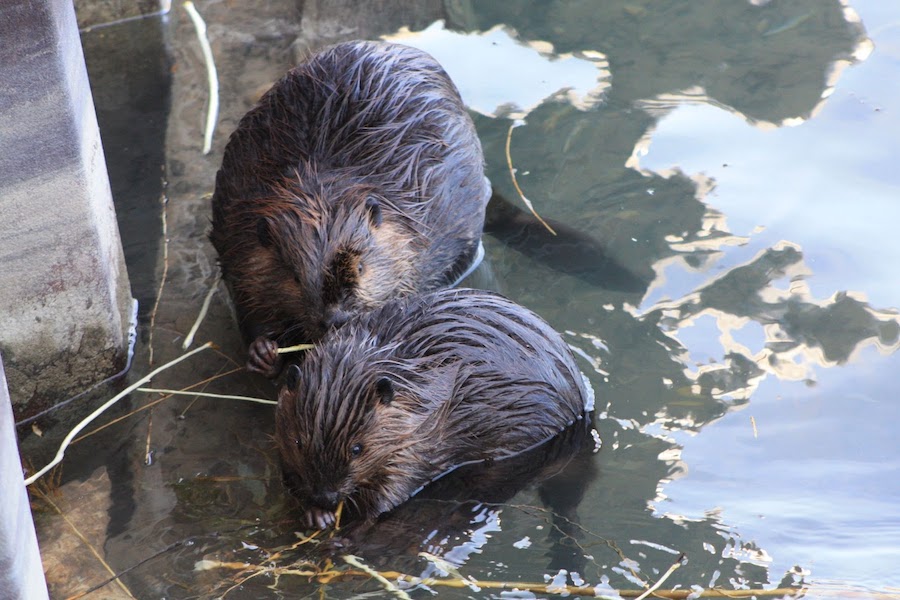Lakefill beavers unite Evanston residents on their daily pandemic walks
Photo courtesy of Tirzah Abbott
The beavers can be seen on the southwest side of the Lakefill, chewing foliage and swimming in the water.
May 17, 2021
In the past year, residents have gathered on the Lakefill for an unexpected reason: a beaver family that lives on its shore.
As part of their leisurely walks or commutes to work, some community members have congregated along the Lakefill pathway near the den. An entire colony can be seen in the early morning and at dusk along the water’s edge.
Tirzah Abbott, the standing electron microscope manager at NU’s Atomic and Nanoscale Characterization Experimental Center, said she frequently visits and photographs the beaver family.
“Around the time of the shutdown last year, when COVID started getting really bad, all of a sudden the beavers appeared,” Abbott said. “I started noticing that they showed up every morning and sometimes in the afternoon, and I just started following them.”
After a 10-year hiatus, the city’s beaver population returned to Evanston’s North Shore Channel in 2012. Commonly known as Illinois’ largest rodents, beavers indicate a clean ecosystem and contribute to its biodiversity.
Abbott said she’s noticed four beavers in total, two adults and two adolescents, that have settled on the Lakefill’s southwest shore.
Chad Goeser, NUANCE center associate administrator, joined the beaver-watching community when NU shut down in response to COVID-19. Goeser said he includes an early morning stop along the water’s edge on his way to work to watch the family playing.
“There’s at least 50 to 100 people that are regularly hanging out, waiting to see the beavers,” Goeser said. “There’s a morning period for about an hour when you can see them eating and playing.”
Abbott said her favorite memory of watching the beavers was hearing one of them sneeze. To her, it sounded like a human. Moments like these feel like a “nice little nature escape” during the pandemic, she said.
While the beaver family brings joy and entertainment to the spectators’ days, they are also known for their demolition of trees, bushes and protected areas along the shore.
NU and Evanston are currently discussing how to address this issue, according to University spokesperson Jon Yates.
“While we have not decided the best approach to mitigating the beavers this spring, we continue to talk with experts and interested parties,” Yates said in a mid-April statement to The Daily.
Evanston resident Mary Mumbrue, said she has noticed the damage caused by the beavers. However, Mumbrue said she hopes the University takes protective measures that keeps the beavers’ health in mind.
She worries because she has not seen the beavers in over two weeks, Mumbrue said. Their absence from her morning routine is palpable, she added.
“For a long time I saw them every day,” Mumbrue said. “It impacted my view of nature because I stopped long enough to pause to look at nature, which I didn’t do before.”
Abbott has seen the beavers more recently, but said she believes they are coming out less frequently because of speculated new offspring in the den.
While she appreciates the beavers, Abbott also said she understands the need to consider the wellbeing of the campus grounds and community safety. She said she hopes the University will be transparent about their plans if they elect to relocate the family of beavers.
“As a follower of these beavers and having them been such a huge part of my experience, especially during a global pandemic, I’d like to know where they’re going,” Abbott said. “I’d like to see the happy ending to the story instead of just coming in and finding that they’re gone.”
Email: annabock2024@u.northwestern.edu
Twitter: @anna__bock
Related Stories:
— Beavers return to Evanston channel
— Northwestern partially closes Lakefill to start a coastal stabilization project
— As colder temperatures bring fewer sightings, students reflect on the abundance of skunks this fall


